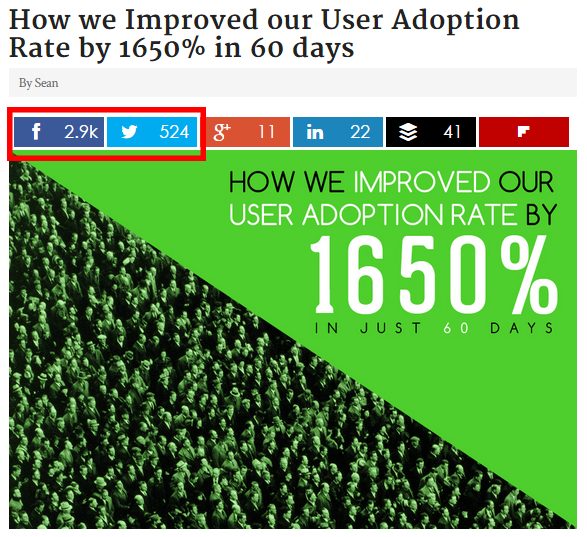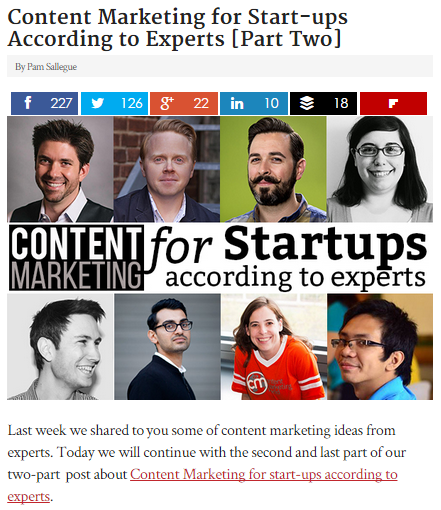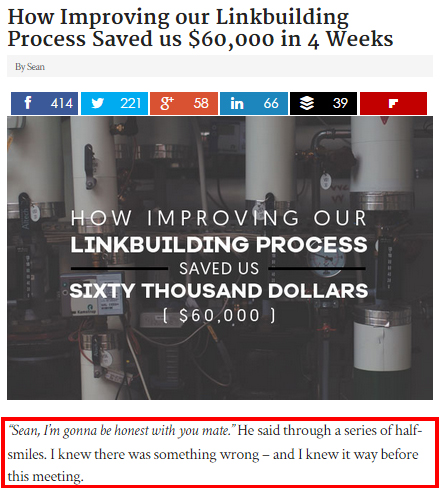The Anatomy of a Viral Content
We all want to create content that will be read, and shared over and over again. But with millions of content published every day, and the huge amount of information available online, it’s hard to keep up with the competition.
All we can do is ask, “how do I get people to read what I write?”
Good thing there are ways to boost your chance of getting viral – I’m sure you don’t need to try all of these in one post, but there’s nothing bad with trying, and I’m pretty confident that following these suggestions will eventually grow your traffic and visibility.
Note: This article will show you the anatomy of a viral content, plus ways to help you create an SEO-friendly content.
Let’s get started!
1. Headline
a. Use number
A study by Conductor shows that headlines with numbers generate 73% more social shares and engagement.
The reason behind the magic of numbers is because our brains are attracted to it. Just like how Debra Jason described it, “numbers are brain candy.”
Our brains are attracted to numbers because they automatically organize information into a logical order. In marketing and advertising, your headline is an advertisement for your content. A single, small odd-numbered digit, like 7 for example, is like candy for your organizational mind.
It’s also interesting to know that using odd numbers is better than even numbers. According to Content Marketing Institute headlines with odd numbers had a 20% higher click-through rate than those with even numbers.
Note: Numbers as figures work better than numbers as words. Yes, that’s right! So the title “How Improving our Linkbuilding Process Saved us $60,000 in 4 weeks” is better than “How Improving our Linkbuilding Process Saved us Sixty Thousand U.S Dollars in Four Weeks.”
Here’s another great example:
b. Use brackets
I didn’t know that brackets can be very helpful until I read Data Driven Strategies for Writing Effective Titles and Headlines. HubSpot blog received a 33% increase in average post views by just using brackets in the title. This is because bracket helps readers see what he’s going to get before even clicking. And as readers, we prefer to have an idea of whatever we’re clicking.
c. Keep it under 70 characters
While there’s nothing wrong with a long headline, it is still suggested to keep it under 70 characters, for reasons that Google will only display the first 70 characters in the SERPs, so users will not see the rest of your title – too bad!
And secondly, Twitter only allows 140 characters. It’s better if you have remaining characters to add a comment, or hashtags when you share your content.
2. URL
a. Use short URL
There’s nothing fun about long URLs. But more than this being my opinion, there are valid reasons why you need to keep your URL short.
Short URLs not only fit into social media posts, but they’re also SEO-friendly because it allows you to contain only your target keyword.
While Google or Bing can both process long URLs, it is best to keep it short for usability and user-experience.
b. Use descriptive URL
I honestly believe that there’s no need for an in-depth analysis to understand why more people will click seo-hacker.com/link-building over seo-hacker.com/post?id478!33.
The purpose of a URL is to give your audience a short summary of what your post is all about, and the chance to prove that you’re credible. Trusted domains use descriptive URL. So, if you really want to look credible, start adding life to your URLs.
c. Avoid stop words
For an SEO-friendly URL, it is best to remove all the stop words. You may use this list of all stop words to know which one to avoid, or simply install plugins like SEO slugs to automatically remove stop words.
3. Image
a. Put colorful a image above the fold
You only have 1.5 seconds to convince your readers to stay in your blog. When you put a colorful image above the fold, you’re given 1.5 seconds to show that your post is compelling enough to be read.
Why colorful? Because 80% of people will more likely read a post with colorful visuals.
But of course, do not disappoint your readers by putting colorful images with low quality content. Your image should always reflect what your article is really about.
b. Avoid stock photos
I’ve seen so many blogs still using stock photos, and it bothers me because most of them actually have great content, but I’m pretty sure they’re missing a big chunk of traffic and shares just because of the images being used.
I mean, we’re tired of overused business handshake, or this-way-to-abstraction street sign stock photos. We want photos that are pleasing to the eyes.
Image quality plays a big role in marketing our content, in fact, content with pro images received 121% more Facebook shares than stock or semi-professional photos.
c. Use featured image
Here’s a great point by Brian Dean. Including a featured image ensures that your social shares also has an image, and social shares with images get 150% more retweets, and 53% more likes on Facebook. Simple as that.
4. Content
a. Create long form content
In MozCon 2015, Matthew Brown explained that while it is believed that 350-500 word articles have higher reads, long form content that is well written is more engaging.
It is when you present a good topic, and write it in a very compelling and interesting way. No matter how long the content is, it is imperative to get readers to spend more time on your page.
b. Use short introduction
Do you know that people only read 28% of a blog post? Yes, that’s right. And that’s also the reason why you need to make the best, and the most concise introduction you can ever make if you want to engage your readers.
Now, that doesn’t mean you need to make it short to the point that people cannot understand what you’re trying to say. Just be straightforward and try to use short sentences, but at the same time make sure it still delivers your real message.
c. Try roundup post (mention influencers)
I’ve written quite a good amount of roundup posts already, and I can say that it’s very effective.
Not just because we like to read articles with credible people being mentioned, but also because when you create a roundup post and you let those influential people know, chances are they will share it, and their followers will read and share it too.
In an article by Brian Lang, published in YouMoz blog, he explained the benefits of conducting a roundup and how one of his expert round up posts received over 1,000 social shares in just 3 days.
d. Storytelling
I love the Groove blog so much, not just because the content are written really well, but also because Alex loves to tell stories, stories about his team, and how they are as a remote team. We love stories, because it’s natural that we’re more convinced when ideas being shared came from real events.
And that’s what we’re doing with SEO Hacker. Once in a while, we share stories about our company, we even share our processes, and how we succeed with every challenge we face as a team. These are real events that people can relate to, and people find it easier to share something when they can relate to it.
Be careful though, stories should be used not for the sake of entertaining, but rather to educate and give value.
e. Maintain your content (evergreen content)
In my last article, I mentioned the importance of updating content. Now you may ask how updating will help with virality.
Simple, keeping your content evergreen, meaning current and relevant, will get tons of visits and shares.
A great example will be Moz’s SEO Free Beginner’s Guide which is still getting a lot of downloads – they update this guide every month. The point is as long as readers find your content relevant, Google will find you relevant too, and will reward you by putting you in the first spot. When you’re in the first spot, chances are you’ll be viral for a long time.
f. Keep sharing buttons above the fold
Social buttons should be visible on your site. If your goal is to get more shares, you have to make it easy for your readers to share your content. While it’s okay to place your social sharing buttons after the post, it is best to place it above the fold to prevent users from scrolling and looking for it – because they might end up frustrated.
Final thought
It’s very challenging to create something that will be viral – some believe it’s luck, but the truth is there are just specific elements that needs to be implemented so people will know that you exist and have something great to offer.
Over to you!
Have you been using these suggested ways already? If not, perhaps you’re thinking of trying out one for now? Share us your insights by commenting below!





